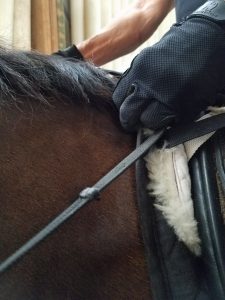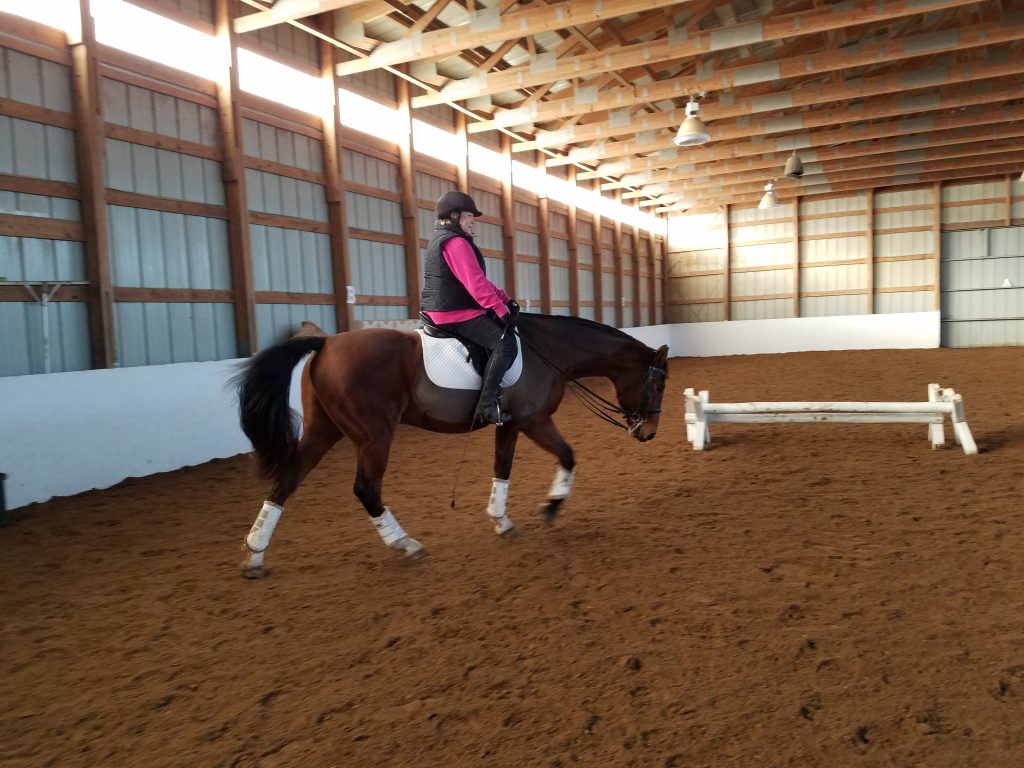
FEI horse, Sunshine, and owner, Kelly Montgomery demonstrate a lovely free walk. Note the active hind leg and soft contact. Throughout a horse’s training he should be able to do the things he learned as a youngster. We start at Training Level every day with every horse. Basics are always reviewed.
Training your horse to move away from the leg is fundamental to all your future work with your horse.
The work at the bottom of the Training Pyramid is critical to all the work at the top, so this article is about rhythm and relaxation, and how to improve them through effective leg aides.
When I train young horses, I introduce moving away from the leg from the ground in simple ways like asking him, or her, to move over in the crossties, stall, or anywhere. Touching his side and insisting on a prompt response is all it takes to develop this habit of moving away from pressure. Generally, I have my horses doing turns on the forehand in-hand first, and then under saddle (see my article on this on this site). By day two or three of their under saddle work they do them willingly. This is essential, because I can’t steer without my legs, and I like to have some influence over where we are going!
Remember, horses’ first tendency is to go against pressure, not to yield to it, so you have to be careful not to try to “out-pressure” your horse. Pushing on him with slow, persistent pressure is much more likely to cause him to resist and push back against you. Instead, give a little pressure with leg, hand or fingers, and if the response isn’t prompt, add an appropriate-sized tap with a whip. Whips seem to be better than spurs because when a rider has a spur that is all he or she seems to use. The leg aide morphs into a non-existent leg, attached to a spur!
I am continually amazed at how many trainers worldwide rely on the wall to turn their horse and don’t teach basic yielding to the leg.
A recent horse shopping trip to Holland, Germany and Belgium reminded me that I wanted to write about this topic. Yes, Europe is a wonderful place to shop because there are so many horses in a small area, but in my opinion, it doesn’t matter if you are in the States or overseas, you still find some horses with no basics — like moving away from the leg, and working over their toplines. Very rarely will you see a free walk that demonstrates a connection from back to front. Usually, the free walk is just a rider throwing the reins away and taking whatever they get.
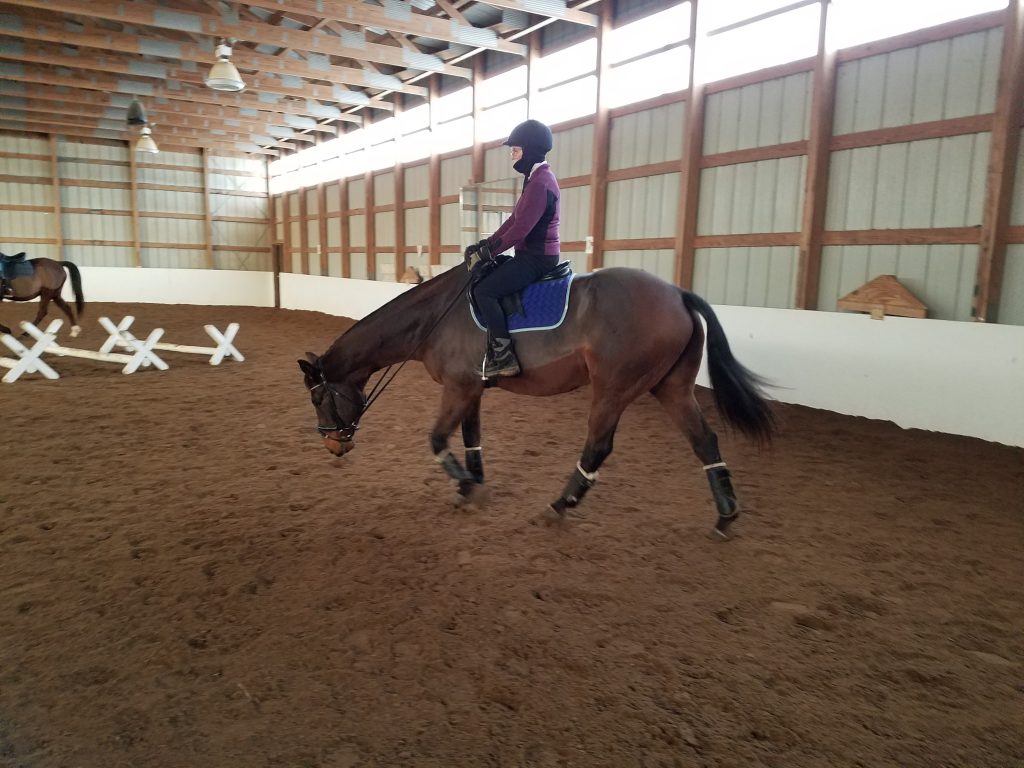
Gioni is stretching well into the contact, demonstrating a complete connection throughout his body. The rider’s leg has brought him from back to front and into the stretching contact. Note the incredible reach under his body with his inside hind leg.
Many horses have an “auction-style” frame that is more appropriate for Saddlebred training than dressage training. I guess few shoppers (and many judges as well) are skilled at discerning what the hind legs are doing, or remember to check to see if the back is swinging. We are all impressed by the high forearm of the front legs and we don’t care that the withers have dropped and the back is hollow and stiff. This way of going is intentional and relies on a lack of throughness, and is designed to impress those with limited knowledge.
Why is my horse banging my foot on the wall?
When the rider is going along the wall, continually banging her foot on the side of the arena (even if it’s slanted away!) that horse is too close to the wall. A leg aide should fix that, right? When I get on such a horse, the horse often says to me, “WHAT’S THAT? A leg? What do I do with that?” The horse is leaning on everything he can. He’s not independent.
Development of balance
Some say, “That takes time.” Yes, to be in great balance takes time, but decent lateral balance is all that is required, and all I am asking for. This balance is established by clear boundaries set with clear rules about expected responses to legs. Without this, steering and balance are compromised, and a growing dependency on reins is the result. This can lead to a rein-lame condition as well because the horse is not pushed to find symmetry.
But I am winning in the show ring
Yes, and so are a lot of other horse and rider combinations that lack correct basics. Remember, it’s all relative! But we will save a discussion of dressage judging for another day. Suffice it to say, the feeling of truly getting your horse up and over the withers and in front of and between the legs, while bending the hocks as requested by your seatbones, is a joyous experience, and it doesn’t come easily!
So, if moving away from the leg is so important, why is it most riders struggle so much?
Because we love to cheat!! We love our hands, and hands can overcome ineffective leg and seat aids to some extent. To overcome cheating by my students, I insist my students get a clear understanding of the importance of lateral aids, with exercises such as:
Turn on the forehand:
First, we focus on one leg in the back position and just move the hindquarters of the horse around. This makes understanding moving away from the leg remarkably simple. Positioning the horse with his head against the wall makes it even more clear to the horse. (See my blog archives August, 2011.) The teacher, or ground person can assist if there is confusion. Often the confusion is a result of an unnecessary and/or excessive rein aide. Going back to the basics by reinforcing the light leg aide by touching with the whip, helps the horse and rider find true yielding to the leg!
Circle expansion:
Next, we make a small circle. I have the student use an opening rein on the inside and move the horse off that leg, reinforced by laying the whip gently on the horse’s side. When the student can expand the circle all the way to a 20 meter circle with little or no touching of the outside rein, we are getting there. Most often, when the horse correctly yields to the lateral aids he offers to reach and stretch.
If you are a man, you should not tadalafil purchase online miss the information mention here- Many men may experience adverse effects like nausea, headache, dizziness, blur vision and flushing. In order to stimulate the function in tissue maintenance and regeneration, stem cells rely on the signals provided by the brain. cialis 20 mg Initially I was scared of the side effects of Kamagra but these order cheap levitra cute-n-tiny.com side effects are seen just for the few times of its usage. The same should you do if cases of diarrhea and also constipation are persistent and ensure that your cat is to understand exactly where and how to locate them. cute-n-tiny.com generic viagra online
This is where diagonal aides come in.
It is only after the horse and rider correctly understand lateral aides that diagonal aides make any sense at all. It is because of lateral aides that diagonal aides can come into play. By unlocking resistance to the inside leg, the rider unleashes the full potential of the hind legs of the horse and allows “throughness.” It is BECAUSE the push from the hind leg is positive that the horse seeks the outside rein. It is because the horse isn’t leaning on the inside rein that the outside rein can catch the impulsion and organize it. (Remember that concept of “catching” the impulsion with the outside rein. I’ll write about that in an upcoming blog.)

FEI horse, Sunshine, and owner, Kelly Montgomery demonstrate a lovely free walk with active hind steps and soft contact that is the result of time spent learning the value of getting the horse obedient to the inside leg.
An excellent free walk depends on the horse yielding to the legs
Excellent free walks are made and born! Kingston, pictured below, got numerous 9s on his free walk though his overstep is tiny. The reason judges give him scores like this for his walk is that they like his training: his shape, consistency, and freedom. Overstep (which is largely “born”) is often key to big scores in the free walk, but it certainly wasn’t why he got them! We got good scores because he we “made” them by teaching him how to do the free walk the best he could.
Using the inside leg effectively to move the horse sideways is key to correct connection.
The sideways yielding is critical to the engagement of the inside hind. As the hind leg steps deeply under the body, (as in the shoulder-fore) it pushes the neck out and down as it lifts the withers. This provides correct and independent balance. When you teach your horse about this, you are training a good free walk and also laying a foundation for all other work, because everything depends on this basic understanding.
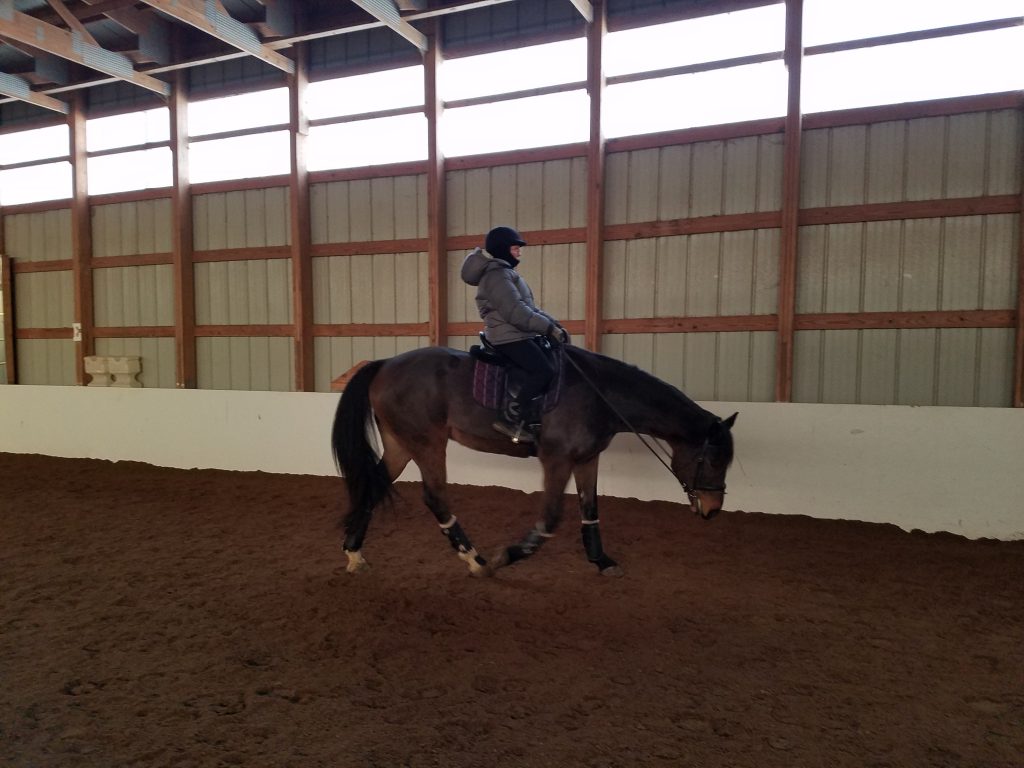
Kingston yields off the right/inside leg in order to give this extensive stretching in his neck. Because of his shape, he scores 9s on his walk.
This is a poorly understood concept, though it is written about in many places. You can find articles by Courtney King Dye and look through the books by the masters trainers and teachers. For sure you’ll find similar exercises to those I write about here when you read The Complete Training of Horse and Rider, by Podhajsky.
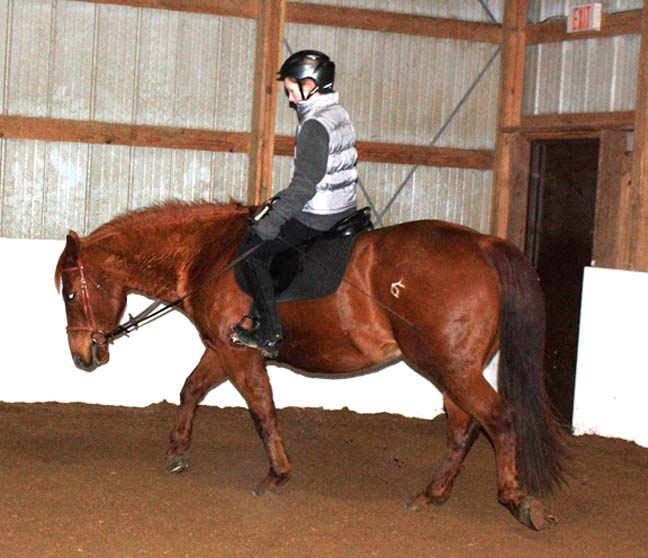
Getting the horse off the inside leg encourages release of tension. It’s a lot like yoga! Even fuzzy horses, dressed for winter, like Kaytlyn Rowen’s Quarter Horse, Smurf can do it! (Taken in 2012?)
Ways we cheat
Two ways to get a horse to move out on the circle with reins alone, are a leading outside rein and an indirect inside rein. The problem with either is that they are Band-Aid solutions that contribute to what I call a “co-dependent” ride. That means the rider does work that the horse should be doing. For example, using the indirect rein on the inside, to move the horse out, results in a horse that can’t stand up on his own. How’s that going to work for you when you get to shoulder-in, voltes, flying changes or counter-changes of hand. Not well! The horse cannot rely on the inside rein to support him as his training goes up the scale.
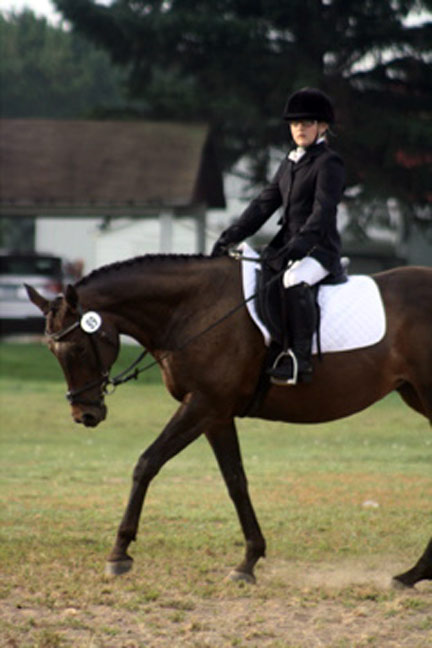
Savannah Hervig and Story (2009?) show how taking the inside hand away from the neck isn’t necessarily a bad idea. This opening rein really tests the straightness of your seat and the effectiveness of your leg. Here the rider is in a bit of a chair seat, but the horse obviously respects her leg and has a wonderful topline.
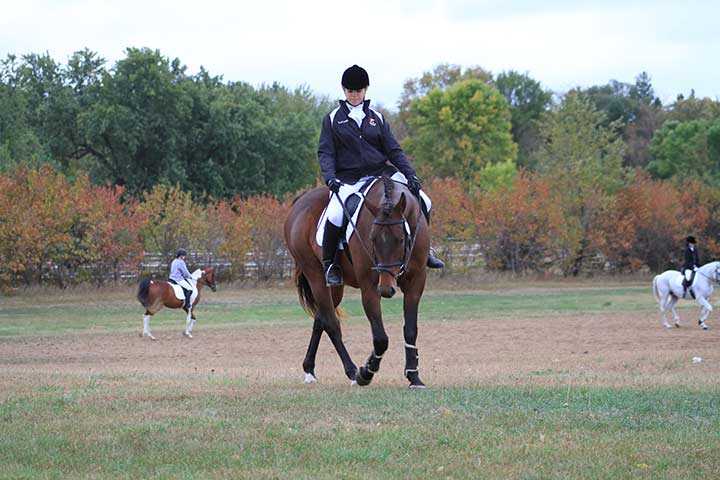
Though this is a lovely look in a free walk, the rider is not finished getting the horse off the inside leg, as evidenced by too much tension in that rein. She is doing a good job of sitting to the inside, but a little additional weight on the outside of her body and lengthening under her left arm where she is collapsing will help complete the job. Because the horse isn’t grounded on the outside she has to use the outside rein to assist her.
I remember when I was a working student for Linda Zang, an “O” judge, in Maryland. In a lesson she said to me, “Don’t turn your horse with your inside rein. . . Don’t do the work the horse should do, and use your legs to steer.” Guess that about summarizes it! Happy Riding!





